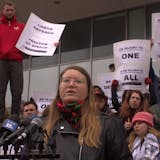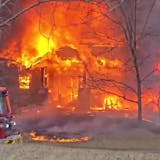We've just had a week like we may never see again. Lord, may we never see a week like that again.
Readers know the context, but we'll recap it briefly for the historical record: A Minneapolis cop kneels on the neck of a prone, handcuffed suspect who complains that he can't breathe. The suspect dies. The event is captured on video and the city erupts in protest, because this is only the most recent loss of a black citizen's life during an encounter with the law and the police culpability strikes most people as hardly debatable.
But the earnest protests are overwhelmed by rioters who spend the next several days and nights smashing windows, looting stores and torching buildings, including a police precinct. The Twin Cities and Minnesota, heretofore known if not exactly famed, earn notoriety by self-destructing as the world watches.
By the fourth day the officer has been arrested and charged, and by the sixth day authorities backed by the National Guard have tentatively reasserted control. It is both that simple and much more complicated, of course. Here are some further questions and observations.
The Saturday-night show of force was necessary after a bungled early response.
The images of National Guard vehicles streaming into the Twin Cities Saturday were both troubling and reassuring. Gov. Tim Walz said repeatedly during the day that curfews would be enforced and that law enforcement intended to restore control. Minnesotans will long debate whether the full-force response would have been needed if officials had moved more decisively earlier in the week, but the widespread chaos had to be stopped.
A coordinated state, local response is critical.
After the worst of the rioting Thursday night and early Friday, Walz called the city's response an "abject failure" during a news conference in which he appeared without Minneapolis Mayor Jacob Frey or St. Paul Mayor Melvin Carter. Walz failed to note that Frey called for the Guard as early as Wednesday. On Saturday and Sunday, the three leaders addressed the news media together and, more important, appeared to be back on the same page.
Officials promised to protect news media but have failed to do so.
Walz and law enforcement officials repeatedly promised that journalists covering the disturbances would be allowed to do their work, but by Sunday a long list of incidents showed that law enforcement had failed that test, either because of confusion, ineptitude or disdain for journalists.
There were extremists, some from outside Minnesota, who exploited George Floyd's death, but we still have much to learn about them.
Public officials gave conflicting accounts when asked about the extent to which outsiders were involved in the rioting, but Walz said it was clear there was "an organized attempt to destabilize civil society." White supremacists? Anarchists? Members of the antigovernment "Boogaloo Bois"? Star Tribune reporter Stephen Montemayor explored the issue in a disturbing Sunday story, and social-media channels were filled with posts on cars with out-of-state plates or no plates at all on the streets of Minneapolis and St. Paul.



